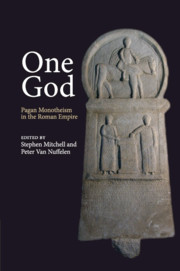Book contents
- Frontmatter
- Contents
- Preface and acknowledgements
- List of abbreviations
- 1 Introduction: the debate about pagan monotheism
- 2 Pagan monotheism as a religious phenomenon
- 3 Pagan ritual and monotheism
- 4 The case for pagan monotheism in Greek and Graeco-Roman antiquity
- 5 Monotheism between cult and politics: the themes of the ancient debate between pagan and Christian monotheism
- 6 The price of monotheism: some new observations on a current debate about late antiquity
- 7 Megatheism: the search for the almighty god and the competition of cults
- 8 Deus deum … summorum maximus (Apuleius): ritual expressions of distinction in the divine world in the imperial period
- 9 Further thoughts on the cult of Theos Hypsistos
- Bibliography
- General index
- Index of authors, works and citations
9 - Further thoughts on the cult of Theos Hypsistos
Published online by Cambridge University Press: 20 May 2010
- Frontmatter
- Contents
- Preface and acknowledgements
- List of abbreviations
- 1 Introduction: the debate about pagan monotheism
- 2 Pagan monotheism as a religious phenomenon
- 3 Pagan ritual and monotheism
- 4 The case for pagan monotheism in Greek and Graeco-Roman antiquity
- 5 Monotheism between cult and politics: the themes of the ancient debate between pagan and Christian monotheism
- 6 The price of monotheism: some new observations on a current debate about late antiquity
- 7 Megatheism: the search for the almighty god and the competition of cults
- 8 Deus deum … summorum maximus (Apuleius): ritual expressions of distinction in the divine world in the imperial period
- 9 Further thoughts on the cult of Theos Hypsistos
- Bibliography
- General index
- Index of authors, works and citations
Summary
PRELIMINARY OBSERVATIONS
My own earlier study of the cult of Theos Hypsistos, published in Athanassiadi and Frede (1999), was an attempt to ascertain whether any form of monotheistic worship could be identified apart from Judaism and Christianity in the Roman and late Roman worlds. The material central to the analysis was the corpus of almost 300 inscriptions, mostly votive dedications, addressed to Theos Hypsistos (180 texts), Zeus Hypsistos (88 texts), or simply Hypsistos (24 texts), dated between the second century bc and the early fourth century ad, which had been identified at find-spots across the east Mediterranean basin, around the Black Sea, in Egypt and in the Near East. Since that study was written, evidence has continued to accrue. By my reckoning, which is certainly not exhaustive, new discoveries have increased the figures for the three groups to 220, 121 and 34 texts respectively, a total of 375. I present a catalogue of these additional texts, geographically organised, as an appendix to this paper, and will cite them as appropriate by the numbers A1 etc., retaining the simple numerals 1 etc. for the items listed in my earlier study. The majority of the new discoveries fit within the pattern of those that were previously known, although some of this evidence prompts further substantial analysis. More important than these finds have been the responses of other scholars, which have called not only the main hypothesis but also my basic approach into question.
- Type
- Chapter
- Information
- One GodPagan Monotheism in the Roman Empire, pp. 167 - 208Publisher: Cambridge University PressPrint publication year: 2010
- 13
- Cited by



